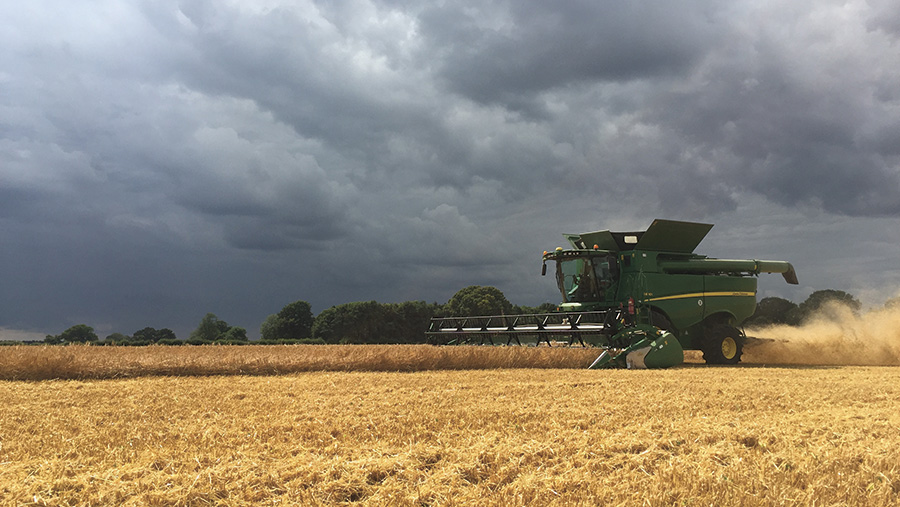Harvest 2016: Wheat grain quality looks better than barley
 © CJB Contraction
© CJB Contraction Wheat quality looks promising and certainly better than winter barley as the first loads were being delivered to grain stores.
In Kent, the first two loads of wheat were delivered to Weald Granary over the weekend (30-31 July), with surprisingly good quality, says store manager John Smith.
A 400t delivery of the milling variety Skyfall had an average specific weight of 79kg/hl, 314 Hagberg and 12.6% protein 1-2%.
A separate 500t load of another milling variety Gallant had a specific weight of 74kg/hl, Hagberg of 309 and 13.3% protein.
Although Hagbergs were about 30 seconds below normal, some grain proteins were up to 14%.
“Wheat harvest will not really start until Monday (8 August), which is about 10 days behind normal,” says Mr Smith.
See also: Early wheat yields show promising yields and quality
Early planted winter barley showed specific weights of 55-58kg/hl, while later-sown crops were better at 57-61kg/hl, while typically winter barley was very thin with poor yields, he adds.
“It has been the worst crop of barley for a few years. Even if we clean it, you have to weigh up the discount and cleaning costs,” he says.
The group has received about 2,000t of oilseed rape, with oil contents at typical levels of 44.5%.
“Farmers are disappointed in the yields, particularly as plantings are down,” says Mr Smith.
Disappointing in Devon
In Devon, harvest was slightly behind normal, with yields and quality both struggling to meet the mark.
Winter barley yields were disappointing and specific weights averaged 62kg/hl, according to Duncan Lyon, store manager at Devon Grain.
“Oilseed rape yields have not been anything fantastic. They have fluctuated wildly with anything that achieves 3t/ha good for this year,” said Mr Lyon.
Despite this, oil contents have been good, averaging 43%, with some as high as 45%. Moisture levels averaged 10.5%.
Barley finished in Wiltshire
In Wiltshire, James Dean had finished harvesting his 243ha of Cassata winter barley at Church Farms, Porton, Salisbury.
Yields averaged 6.7t/ha and specific weights were between 58kg/ha and 60kg/hl.
“Last year the specific weights were up in the 70kg/hl area,” says Mr Dean.
He was three-quarters of the way through combining his 405ha of high-oleic, low-linolenic oilseed rape when the rain set in.
So far the V295OL and V316OL had yielded an average of 3.5t/ha.
Oats and spring barley were almost fit and would be ready to combine from the end of the week, weather permitting.
High screening in Norfolk
The winter barley harvest proved to be disappointing in Norfolk, as specific weights were low, with the bulk coming in at 58kg/hl to 59kg/hl, says Andrew Dewing, Chief Executive at Dewing Grain.
With about 90% of the crop now cut, screenings were into the 30s as the grain was incredibly thin, he adds.
Oilseed rape harvest had just started, with yields reaching up to 4.5t/ha – although heavier land wasn’t performing so well.
“The larger the rotation and the further north, the better the yields seem to be,” said Mr Dewing.
With about 20-25% of the rapeseed intake processed, oil contents were mostly between 44% and 46%.
One or two fields of spring barley had been flattened in the recent stormy weather, but other crops looked promising, said Mr Dewing.
“Fusarium is fairly prevalent in the wheat but hopefully we can screen the small grains out.
“I am not holding my breath for more than average yields, and I am pretty certain they will be below average,” he says.

